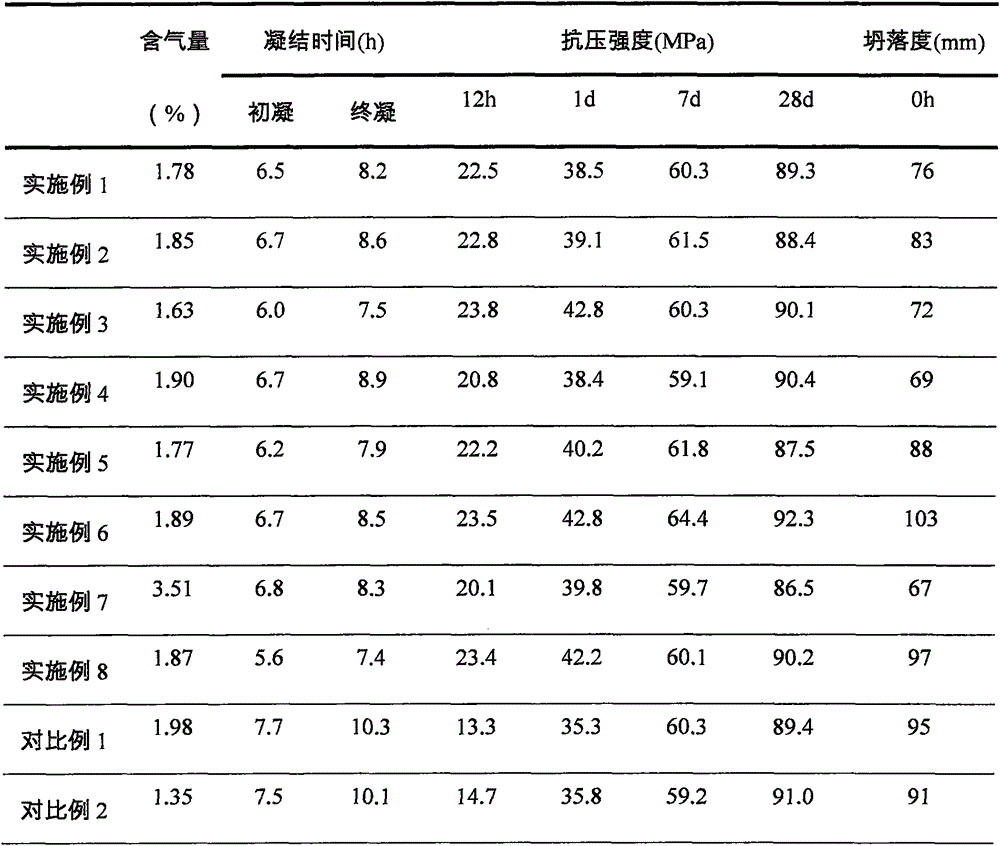Early strength polycarboxylic acid water reducing agent and preparation method thereof, and cement admixture
A technology of polycarboxylate and early-strength type, which is applied in cement admixture, early-strength polycarboxylate superplasticizer and its preparation field, can solve the problems of few mature products and single varieties, and achieve short production cycle, The effect of low cost and reduced production energy consumption
- Summary
- Abstract
- Description
- Claims
- Application Information
AI Technical Summary
Problems solved by technology
Method used
Image
Examples
Embodiment 1
[0058] Into a glass reactor equipped with a thermometer, stirrer, dropping funnel, and reflux condenser were charged 100 parts of deionized water, 92 parts of monomer A (diallylamine ethoxylate with a molecular weight of 2400) and 184 parts of Monomer C (3-methyl-3-butenyl polyoxyethylene ether TPEG with a molecular weight of 2400, and then heated to 65°C, and then 28 parts of acrylic acid and 4.1 parts of methyl alcohol were added dropwise within 3 hours and 3.5 hours, respectively. 40% mixed aqueous solution of sodium allyl sulfonate and 1.2 parts of sodium hypophosphite and 3.8% aqueous solution of 2 parts of ammonium persulfate. Afterwards, the temperature was kept at 65° C. for 1 hour to complete the polymerization reaction, and then the resulting reaction mixture was cooled to no more than 50° C., and then neutralized with 41 parts of 30% aqueous sodium hydroxide solution to adjust the pH to 5-7, thereby obtaining an aqueous copolymer solution for cement admixtures. The w...
Embodiment 2
[0060] Add 100 parts of deionized water, 92 parts of monomer A (diallylamine polyoxyethylene polyoxypropylene ether with a molecular weight of 2400 and 184 parts of monomer C (2-methyl-allyl polyoxyethylene ether HPEG with a molecular weight of 2400), and then heated to 65°C, then added dropwise 28 parts of acrylic acid and 4.1 parts of Sodium methallyl sulfonate and 1.2 parts of sodium hypophosphite in 40% mixed aqueous solution and 2 parts of ammonium persulfate in 3.8% aqueous solution.Then keep the temperature at 65°C for 1 hour to complete the polymerization reaction, then the resulting reaction mixture Cool to not more than 50°C, and then neutralize with 41 parts of 30% aqueous sodium hydroxide solution to adjust the pH to 5-7, thereby obtaining an aqueous copolymer solution for cement admixture, the weight average molecular weight of the copolymer being 28100.
Embodiment 3
[0062] Into a glass reactor equipped with a thermometer, stirrer, dropping funnel, and reflux condenser were charged 100 parts of deionized water, 92 parts of monomer A (diallylamine polyoxyethylene ether with a molecular weight of 5000), and 184 parts of Monomer C (3-methyl-3-butenyl polyoxyethylene ether TPEG with a molecular weight of 2400), and then heated to 65°C, then added dropwise 28 parts of acrylic acid and 4.1 parts of Sodium methallyl sulfonate and 1.2 parts of a 40% aqueous solution of sodium hypophosphite and 2 parts of a 3.8% aqueous solution of ammonium persulfate. Thereafter, the temperature was kept at 65° C. for 1 hour to complete the polymerization reaction, and then the resulting reaction mixture was cooled to not more than 50° C., and then neutralized with 41 parts of 30% aqueous sodium hydroxide solution to adjust the pH to 5-7, thereby obtaining Copolymer aqueous solution for cement blends, the weight average molecular weight of the copolymer is 33400. ...
PUM
| Property | Measurement | Unit |
|---|---|---|
| slump | aaaaa | aaaaa |
Abstract
Description
Claims
Application Information
 Login to View More
Login to View More - R&D
- Intellectual Property
- Life Sciences
- Materials
- Tech Scout
- Unparalleled Data Quality
- Higher Quality Content
- 60% Fewer Hallucinations
Browse by: Latest US Patents, China's latest patents, Technical Efficacy Thesaurus, Application Domain, Technology Topic, Popular Technical Reports.
© 2025 PatSnap. All rights reserved.Legal|Privacy policy|Modern Slavery Act Transparency Statement|Sitemap|About US| Contact US: help@patsnap.com



